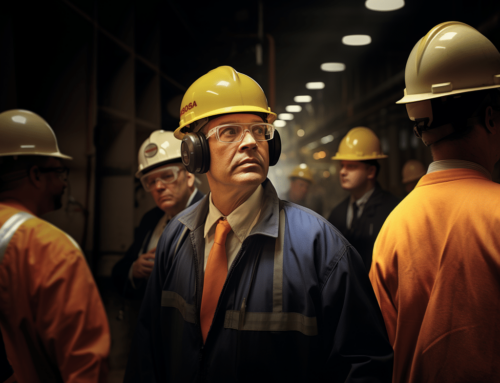OSHA’s Stance on Workplace Noise Exposure
The Occupational Safety and Health Administration (OSHA) reports that each year, millions of workers face exposure to potentially harmful noise levels in their workplaces. While the primary concern is the health implications of hearing loss, the financial repercussions for businesses are also significant. In the previous year, businesses faced over$1.5 million in fines for not providing adequate hearing protection devices against high noise levels. Additionally, hearing loss disability claims account for an annual$242 million in worker’s compensation.
Determining Safe Noise Levels
It’s essential to understand that both continuous excessive noise and intermittent loud noises can cause irreversible hearing damage. OSHA may issue citations to employers who fail to safeguard their employees from such risks. The safety parameters for noise levels are determined by two factors: the decibel level and the duration of exposure. While many audiologists caution against prolonged exposure to noise levels exceeding 70 decibels, OSHA’s threshold for an eight-hour workday is set at 85 dB. Any noise level above 85 decibels becomes increasingly hazardous without proper hearing protection. OSHA’s guidelines suggest that for every 5 dB increase, the permissible exposure time should be halved. For instance, at 95 dB, exposure should not exceed four hours. Hearing protection devices such as earplugs and earmuffs are crucial to safeguarding oneself from workplace noise.
A straightforward way to gauge if your workplace might have excessive noise is to observe if employees need to raise their voices to communicate at arm’s length. For a more precise assessment, consider using the NIOSH Sound Level Meter App, a free tool that provides insights into workplace sound levels, decibel level. NIOSH Sound Level Meter App. If readings consistently exceed 85 dB, further evaluation and action are recommended.
Addressing Excessive Noise Levels
Many industries might be unaware that OSHA advises conducting a noise and dosimetry study biennially and after any significant changes to a workspace. A noise dosimeter, a specialized sound level meter, is attached to an employee temporarily. This device measures noise exposure throughout the day, even as employees move between different environments, capturing intermittent loud noises. If your workplace’s decibel level surpass the OSHA limit of 85 dB, it becomes mandatory to establish a Hearing Conservation Program. These programs are crucial for both employee health and minimizing organizational liability. Should you need guidance on performing a noise survey or creating a comprehensive hearing conservation program, we are here to assist.
Our team, comprising NASED Certified Technicians and Occupational Audiologists, is equipped to conduct noise surveys and dosimetry studies. We document facility noise measurements and offer recommendations, including the use of earplugs, to ensure OSHA compliance.
Frequently Asked Questions (FAQs)
Q1: What is the primary purpose of OSHA’s noise regulations?
A: OSHA’s noise regulations aim to protect workers from the harmful effects of excessive noise exposure in the workplace. Prolonged exposure to high noise levels can lead to permanent hearing loss, tinnitus, and other health issues. By setting guidelines and standards, OSHA ensures that employers take necessary precautions to safeguard their employees’ hearing health with hearing protection devices.
Q2: How often should a workplace conduct noise level assessments?
A: OSHA recommends that workplaces conduct a workplace noise and dosimetry study every two years. Additionally, any significant modifications or changes to the work environment that might affect noise levels should prompt a new assessment to ensure continued compliance with OSHA’s standards. Earplugs are one of the effective hearing protection devices.
Q3: What is a Hearing Conservation Program, and why is it essential?
A: A Hearing Conservation Program is a comprehensive approach to protect workers from hearing loss due to high noise levels in the workplace. The program includes regular noise assessments, employee training on the risks of noise exposure and protective measures, provision of hearing protection devices like earplugs, and regular audiometric testing to monitor employees’ hearing over time. Implementing such a program is crucial not only for employee health but also to minimize organizational liability and ensure compliance with OSHA regulations.
Q4: Are there any tools or apps to help measure noise levels in the workplace?
A: Yes, the NIOSH Sound Level Meter App is a free tool designed to provide insights into workplace sound levels. It’s an easy-to-use application that can help employers and safety officers understand the noise levels in different work environments. If readings consistently exceed 85 dB, it indicates the need for further evaluation and protective measures such as earplugs.
Q5: What steps should an organization take if noise levels consistently exceed OSHA’s limit?
A: If noise levels in a workplace consistently surpass the OSHA limit of 85 dB, the organization should:
- Conduct a thorough noise and dosimetry study to understand the sources and patterns of noise.
- Implement a Hearing Conservation Program.
- Provide employees with appropriate hearing protection devices.
- Offer regular training sessions on the importance of hearing protection and the correct use of protective equipment.
- Monitor employees’ hearing through periodic audiometric testing.
- Make necessary modifications to the work environment or processes to reduce noise levels, if possible.
In today’s dynamic work environments, the importance of safeguarding employees’ hearing health cannot be overstated. As OSHA’s regulations and guidelines emphasize, consistent monitoring and proactive measures are crucial to prevent the detrimental effects of excessive noise exposure. Not only does this protect the well-being of employees, but it also shields organizations from potential financial repercussions. By understanding the significance of noise levels, utilizing tools like the NIOSH Sound Level Meter App, and implementing comprehensive Hearing Conservation Programs, businesses can create a safer, more compliant, and productive workplace. As we move forward, let’s prioritize the auditory health of our workforce by implementing effective workplace hearing protection devices, recognizing that it’s not just a regulatory obligation, but a fundamental responsibility to our most valuable asset – our employees.







